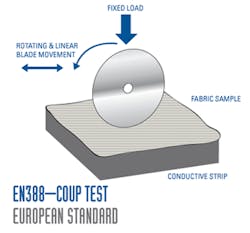Despite educational efforts, there remains an unsettling level of confusion about cut-resistant gloves. With multiple 1-to-5 rating scales, a variety of acceptable or certified standards and differing testing methods, as well as a slew of acronyms associated with glove testing, safety managers may find themselves overwhelmed when sifting through potential cut-resistant PPE. It's therefore vital that those choosing PPE are fully informed on the cut-resistant products available to them.
See Also: Personal Protective Equipment (PPE) Safety Standards
Here is what you need to know about cut testing standards and how they apply to your safety program:
U.S. vs. European Standards
The United States uses ISEA/ANSI-accepted standards, while Europe uses CEN certification – Many gloves sold in North America, however, will indicate both testing results. Keep in mind that the ISEA (International Safety Equipment Association)/ANSI (American National Standards Institute) is a committee of manufacturers and suppliers of safety equipment, as well as a group of standardization societies, which have established a standardized test for cut-resistant materials. On the other hand, the CE (Conformité Européenne) score of a glove is an actual certification, verifying a product properly has been tested and the test results properly reported. Many manufacturers in North America will seek CE compliance, as it is required in Europe and other parts of the world.
ISEA/ANSI accepts the ASTM cut test standard, while the CE certification accepts the EN and ISO test standards – While both parties report cut-resistance on a numerical scale from Level 1 to Level 5, there are differences in these scales. A glove with ISEA/ANSI Level 3 cut resistance may not necessarily test at Level 3 on the CE method. The reason for this difference in the rating scale is the difference in accepted testing methods:
- The ASTM F1790 measures the weight in grams needed to cut through a material when applied to a razor blade, tested over a distance. Thus, each cut level from 1 to 5 denotes a specific range of weight, in ascending order.
- The EN388 Coup testing method is constructed much differently; it counts the rotations needed for a circular blade to cut through a material while moving laterally across the material. The count is indexed by use of a "control” fabric, such as standard cotton. This indexed value is then converted to a simple cut level, ranging from Level 1 to Level 5.
- However, the EN388 Coup test is not recommended for materials with high levels of cut resistance, as these materials easily can dull the blade and skew the results. For CE cut levels of 4 and 5, an alternate test is proposed – the ISO 13997. Similar to the ASTM F1790, it measures the force needed to cut a material by way of a straight blade being moved across material. The result is measured in newtons, which directly is translated to cut-resistance .
North American manufacturers and distributors are not required to certify their cut resistance – As the CE is the only certification-requiring body, vendors of safety gloves in North America are not required to test them for cut resistance. If they elect to test them for cut resistance, they can use any method they choose. Furthermore, the CE certification does not require the ISO 13997 for highly cut-resistant materials, but only recommends it. It is extremely important to gather information both about the material used in PPE, as well as the methods by which it is tested, before continuing with a purchase decision.
Test results from various tests are not easily interchangeable – Though many manufacturers will demonstrate the CE cut tests as a function of weight or force, this conversion is only a rough estimate of how the material will perform. Each test and testing standard is different in the way that it is performed, and thus, only will be loosely comparable by way of reporting results.
The employer ultimately is responsible for providing PPE that meets employees' needs – Per OSHA regulations, the final burden of responsibility conMichael Ens is the marketing content manager and senior writer for HexArmor, specializing in hand safety applications. Visit www.hexarmor.com for more information.


